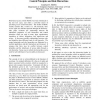Free Online Productivity Tools
i2Speak
i2Symbol
i2OCR
iTex2Img
iWeb2Print
iWeb2Shot
i2Type
iPdf2Split
iPdf2Merge
i2Bopomofo
i2Arabic
i2Style
i2Image
i2PDF
iLatex2Rtf
Sci2ools
RBAC
1998
1998
Control Principles and Role Hierarchies
Role-based access control (RBAC) has been introduced in the last few years, and offers a powerful means of specifying access control decisions. The model of RBAC usually assumes that, if there is a role hierarchy, then access rights are inherited upwards through the hierarchy. This paper examines the relationship between the inheritance properties of role hierarchies and control principles which are used in many large organisations: separation of duties; delegation; and supervision and review. It discusses possible relationships between roles and identifies three different kinds of role hierarchy. The control principles and role hierarchies are illustrated in a realistic application, and their interactions are discussed. It emerges that there may be conflict between control principles and the inheritance of access rights through a role hierarchy. Some ways in which role hierarchies can be used for safe inheritance of access rights are discussed.
| Added | 01 Nov 2010 |
| Updated | 01 Nov 2010 |
| Type | Conference |
| Year | 1998 |
| Where | RBAC |
| Authors | Jonathan D. Moffett |
Comments (0)

